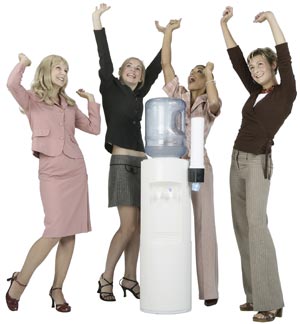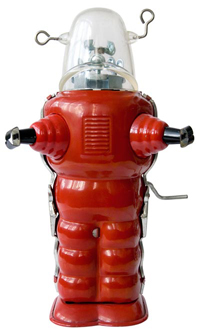Have Fun at Work and Increase the Bottom Line
By Marelisa Fabrega
Traditional wisdom states: "Work is not supposed to be fun. That's why it's called work." A corollary of this principle states that if you see someone having fun at work, that person is slacking off. However, research shows that this dismal view of work is completely wrong.
In The Levity Effect: Why it Pays to Lighten Up, bestselling author Adrian Gostick and humorist Scott Christopher use science to reveal the power of humor and fun in business.
Through interviews, exercises, and case studies, the book reveals how humor in the workplace helps build camaraderie, increases productivity, enhances employee satisfaction and loyalty, and encourages creativity and innovation for a better workplace and bigger profits. Two examples cited in The Levity Effect of how some highly successful companies make work fun for their employees are the following:
• Employees at Lego America travel around campus on scooters.
• At Microsoft, they blast music at three o'clock when everyone's energy is starting to slump. Some people get up and dance, and everyone claps when the song is over.

Gostick and Christopher point out that an organization called the "Great Place to Work Institute"--which has asked tens of thousands of employees to rate their experience of workplace factors--has consistently found that companies that are classified as "great" score unusually high marks from employees on the question: "Are you working in a fun environment?" Great companies scored 81% on this, compared to 62% for companies ranked "good".
Here are some more findings by the authors of The Levity Effect:
• A study of 737 chief executives of major corporations found that 98% would hire an applicant with a good sense of humor over one who seemed to lack one.
• The research firm Ipsos surveyed 1,000 employees, and those who rated their manager's sense of humor "above average" said there was a 90 percent chance they'd stay at the job for more than a year. Employees who rated their manager's sense of humor as "average" or "below average" rated their chances of staying at only about 77.5%.
• A study in the Harvard Business Review indicates that executives described by co-workers as having a good sense of humor climb the corporate ladder more quickly and earn more money than their peers.
So how can a company encourage fun at work?
Here are 20 ideas:


"A company that has fun, where employees...put cartoons on the wall and celebrate, is spirited, creative, and usually profitable." -- David Baum
1. A company in California distributes page-a-day calendars on different subjects to employees at the beginning of each year. The subjects range from "Jeopardy" to Dilbert cartoons to gardening tips. Since everyone's calendar is different, employees share the tips, jokes, or riddles that they get each day with everyone else. Follow their lead and do something similar.
2. On the third Thursday of the month, go to a pub for food and/or drinks and celebrate achievements, anniversaries, birthdays, and just making it through another month.
3. Decorate the workplace.
4. Install a basketball hoop in the parking lot and start a tournament for employees during the lunch break.
5. Organized goofing around can foster team spirit and increase creativity. Contests like relay races in office chairs and team Nerf gun fights help break up a workday and allow everyone to bring a renewed spirit to their work.
6. Have a Laughter Yoga session before each meeting.
7. Build a Wall of Fame. Decorate it with awards, thank you notes from clients, news clippings of your company's successes, and so on.
8. Create a humor bulletin board. Make it a point to look for cartoons and jokes which poke fun at the circumstances that cause negativity or conflict in the office. Start with a blank board each Monday morning. However, keep the old ones and put them together in a scrapbook. Award the scrapbook to the employee who does the most to foster good humor in the workplace.
9. Have a "Success Bell". When someone in the office helps a client or makes a new sale, they ring a bell and everyone cheers.
10. Turn the coffee room into a humor room by stocking it with stand-up comedy routines on DVD or audiotapes.
11. Mary Owen from Oracle Corp. says, "We are under a lot of pressure, and toys are our comfort. We need them like Linus needs his blanket." Toys for the office can include Koosh balls, a foosball table, Pez dispensers, hula hoops, a sand tray, wooden blocks, origami paper, and so on.
12. Work together to create a mural on an office wall, or create some other type of art together.
13. Have a pizza and ice cream social each time an important goal is reached.
14. Take candid photos of employees at work and hang the pictures up on the bulletin board.
15. Give juggling kits to all your employees and have a "meeting" in which everyone learns to juggle. Once a quarter you can have a meeting that's not business related.
16. When tensions get high at Social Sauce, a user-generated content and communication platform in New York City, employees break out foam swords. "In an office of mostly Internet and tech males, the sword fights diffuse tension by allowing co-workers to play similarly to the online games they play or develop," explains Jenn de la Vega, a marketing assistant there.

17. A high-tech company in Reston, Virginia posts a riddle in their weekly newsletter. The first person to answer the riddle correctly receives a small gift valued at $5 or less. The gifts are often nostalgic toys, like a Slinky, Play-Doh, and other items that can be played with or shared around the office. A company representative stated, "Everyone in the office looks forward to seeing what is awarded that week. The toys often get passed around and borrowed. It's a big hit!"
18. Colleen Barrett, who retired as CEO of Southwest Airlines, sent over 3,000 handwritten notes every month for nearly 30 years thanking employees for specific things they had done to improve the passenger experience for Southwest customers.
19. A "fun committee" should be formed to find effective ways to add fun to work. The committee should consist of representatives from a wide range of departments, and committee membership should rotate.
20. Allow your employees to be spontaneous. On a Southwest Airlines flight, flight attendant David Holmes spontaneously decided to rap the safety instructions at the beginning of the flight. It was a big hit with passengers and now he does it all the time.
Thomas Edison knew the value of making work fun. Toward the end of his life he said, "I never did a day's work in my life--it was all fun."
|




